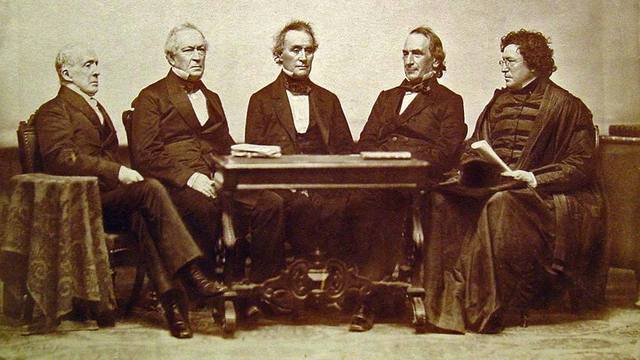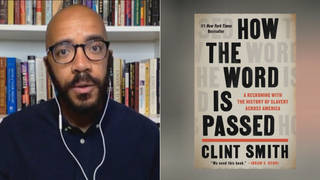
On Wednesday, we will interview Massachusetts Institute of Technology history professor Craig Steven Wilder, who spent a decade researching Ebony & Ivy , about how many universities — such as Harvard and Yale — relied on slavery, and bred racist ideas. Below you can read the prologue from his new book. Click here to see all Democracy Now! coverage of issues related to important moments in African-American history.
Excerpted from “Ebony & Ivy: Race, Slavery, and the Troubled History of America’s Universities” by Craig Steven Wilder. Copyright © 2013 by Craig Steven Wilder. With permission of the publisher, Bloombsbury Publishing.
Prologue: A Connecticut Yankee at an Ancient Indian Mound
“Remember me to all my friends and relations — I wish you and others of the family as many as can write to write to me often and tell me about everything and anything,” Henry Watson begged his father, “about everybody and thing I care anything about.” Written from New York in November 1830, where the young man had booked passage on the schooner Isabella to Mobile, Alabama, the letter mixed a premature homesickness with a sense of youthful expectation. Watson was from East Windsor, Connecticut, just north of Hartford, and he was heading south to find work as a teacher in an academy or on a plantation. He carried a packet of introductory letters from his professors at Washington College (Trinity) in Hartford and Harvard College in Cambridge, family friends including Professor Benjamin Silliman of Yale College, and his father’s business acquaintances. After graduating from Yale, Silliman had considered a job in the South, and his brother Selleck did leave Yale to become a tutor in Charleston, South Carolina.
College initiated Henry Watson into the slave regimes of the Atlantic world. The founding, financing, and development of higher education in the colonies were thoroughly intertwined with the economic and social forces that transformed West and Central Africa through the slave trade and devastated indigenous nations in the Americas. The academy was a beneficiary and defender of these processes.
College graduates had exploited these links for centuries. They apprenticed under the slave traders of New England, the Mid-Atlantic, and Europe. They migrated to the South and to the West Indies for careers as teachers, ministers, lawyers, doctors, politicians, merchants, and planters. The end of the slave trade and the decline of slavery in the North did not break these ties. The antebellum South
represented a field of opportunity, where the wealth of the cotton planters was funding the expansion of the educational infrastructure.
The Isabella could carry a handful of passengers, and Watson had a small, comfortable cabin. He stored his trunk on board and then explored New York City while he waited for departure. He detailed his spending, documented his efforts to be frugal wherever possible, and sent weekly updates on his progress to his father. Those communications were also filled with complaints about things like the cost of the books that he needed to further his education. Like Selleck Silliman, Watson did not intend to spend his life as a plantation teacher. He wanted to earn a salary for a year, improve his health in a warmer climate, and then study law. Later that month, this 20-year-old aspiring tutor boarded the schooner for the voyage south.
An education in Hartford and Cambridge was reasonable preparation for living among the slaveholders of Alabama. The presidents of Connecticut’s colleges and universities led one of the most extreme branches of the American Colonization Society — founded in 1817 to transplant free black people outside the United States. New England’s colonizationists cast African Americans as a threat to democracy and social order, encouraged campaigns to halt the development of free black communities, and even destroyed schools for African American children. They silenced debate about slavery and vehemently attacked abolitionism as the cause of political tensions between the slave and free states.
Harvard was approaching its two hundredth anniversary, which meant that it was also nearing the bicentennial of its intimate engagement with Atlantic slavery. Beginning with the first graduating class, boys from Cambridge had been seeking fortunes in the plantations. By the time Henry Watson matriculated, Harvard’s history was inseparable from the history of slavery and the slave trade. College had armed Watson with theories of racial difference and scientific claims about the superiority of white people. The academy refined these ideas and popularized the language of race, providing intellectual cover for the social and political subjugation of nonwhite peoples. In a class with the Harvard anatomist John Collins Warren, Watson learned that in physical development, cultural accomplishment, and intellectual potential, black people sat at the bottom of humanity. Professor Warren also revealed that the most advanced scientific research confirmed the biological supremacy of the boys in that room. It is likely that Henry Watson Jr. already believed in the natural dominion of white people, and that the scientific certainty with which most of his professors argued the primacy of Europeans and the backwardness of Africans only confirmed his views. Harvard, like Washington College, was a pillar of the antebellum racial order. Not only were the students, the faculties, the officers, and the trustees white, but people of color came to campus only as servants and objects.
From Mobile, Watson traveled north toward Greensboro, through territories where “plantations are very thick.” It was now December and he was focused on securing a salary. “These regions seem to be a fine place for female teachers, they are in great demand,” he reported despondently to his father. He still could not find a teaching job at an academy or on a plantation, and an opening at the public school “would but little more than pay my board.” While in Greensboro, he called upon Dr. John Ramsey Witherspoon — a South Carolina relative of the Reverend John Witherspoon, president of the College of New Jersey (Princeton) and signer of the Declaration of Independence — who was rumored to be in need of a teacher. The six months since Watson left home had been spent to little profit, which was all the more disappointing and insulting in a place he believed to be dominated by greedy planters, and where “the people are almost ignoramuses on some things. The Doctors are miserable, the Lawyers are not much better.” To make matters worse, he lost his purse from a torn coat pocket. “It was one of the Christmas holidays and the streets were full of negroes,” he explained, “so that I hardly expect to hear from it again.” He went out with his host in search of the wallet but found nothing. The next morning, apparently unconscious of irony, he dispatched “a negro to hunt for it but unsuccessfully.”
“i passed an indian mound”
In May 1831 this would-be tutor packed his belongings and prepared to leave Alabama on horse back. The idea of returning to New England by horse likely had come from Caleb Mills, a New Hampshire resident who graduated from Dartmouth College in 1828. The two men passed near Northampton, Massachusetts, as Watson was beginning his trip south. Mills later became professor of Greek and Latin at Wabash College and superintendent of education in Indiana. Watson took note of a particular piece of information during the exchange: “He said he had rode that same horse five or 6,000 miles at the rate of 40 and 50 miles a day. Had just come from Kentucky.” Short on cash, the young tutor chose that same method for his return. It was the perfect way to learn the geography and history of the region. “I passed an Indian mound different from most … It appeared like a pyramid with a square base cut of about 15 ft. high. It is a regular square,” Watson excitedly jotted while outside Tuscaloosa. He had already seen Indian mounds, and had stopped to carefully examine one near Carthage. He began searching for mounds and artifacts. The very next day, Watson rode through a portion of the “lands of the Cherokee nation” near the Tennessee border, but he “saw no indians or indian relics.”
That area was part of an enormous expanse of territory — tens of millions of acres — that the state and federal governments seized from Native nations and tribes, the most recent in a succession of
human tragedies that transformed the demography of North America. Prior to the “Great Dying,” an estimated four million people lived in the greater Mississippi Valley. New waves of death had come with the expansion of European outposts two centuries before Watson’s journey. Violent raids into the interior from the Carolina colonies transferred microbes inland, forced flights and migrations
that upset the socioeconomic order of indigenous societies, altered age distributions, and caused abrupt changes in diet and health that made the new diseases more deadly. Watson’s attention had
been drawn to the remnants of these civilizations— monumental architecture constructed at least a millennium before Stonehenge. The largest ruins in the Mississippi and Ohio valleys, equal in size
and crafting to the pyramids of Egypt, could hold St. Peter’s Basilica and its gardens. These sites were once the centers of civilizations supported by trading networks that stretched across the continent.
There is a background to Watson’s interest in these archaeological remains. As an undergraduate he had lived on campuses that were decorated with Indian bones and artifacts and that hosted lively discussions of the impending extinction of Native peoples, legacies of a long relationship between colleges and conquest. European nations founded academies to secure their colonial interests, and they supported these schools by exploiting the decline of Indian nations and the rise of African slavery.
A young college graduate riding horseback over ethnically cleansed lands carved into slave plantations had plenty to ponder. Watson’s mind was quite busy. He marveled at the beauty and richness of the region. He saw planters driving Indians from the path of cotton, and took notes on the crop economy, hauling distances, and regional markets. At the home of a man whom he met on the road, he watched forty enslaved black people working 350 acres. “Cotton plantations go as far as the eye can reach. Corn, rye, and wheat abound. Large bodies of Negroes at work,” he recorded as he passed from Alabama to Tennessee through Cherokee country. He was, it is fair to note, impressed with the rewards of human slavery. When he reached Kentucky in June, he used his letters of recommendation to gain an audience with Henry Clay. “Said to be well off but not rich,” Watson added after a lengthy and pleasant visit with the Great Compromiser, the senator and colonizationist who for a generation managed the political conflicts between the slave and free states.
Henry Watson’s generation had begun to wrestle, albeit poorly, with the moral and social implications of this history. In September 1831 — shortly after Watson had returned to Connecticut — James Kent delivered the Phi Beta Kappa lecture during Yale’s commencement. In 1793 Kent had become the first law professor at Columbia College in New York City. He bought a house, purchased an enslaved woman, and became a colonizationist and a prominent opponent of extending suffrage to free black people in New York State. Kent celebrated his chapter’s fiftieth anniversary with a lecture that used science, theology, and history to proclaim the inevitable rise of the Europeans. It was the will of God that “the red men of the forest have … been supplanted by a much nobler race of beings of European blood,” he began. It would have been a sin and “a perversion of the duties and design of the human race” to permit “roving savages of the forest” to maintain these lands as “a savage and frightful desert.”
“Yankees and Planters”
Henry Watson was quite happy to get back to northern soil, but he was also allured by the wealth that he had seen in the South. He studied law under Henry Barnard, a Yale graduate who later served as a state and federal education commissioner. Although he claimed to hate slavery, Watson left Connecticut for Greensboro, Alabama, after just a couple of years, set up a law practice, and became a slave owner — a “sin,” he confessed, but one that promised great benefits. Shrewd investments following the Panic of 1837 increased his wealth. He snatched up plantations and slaves in what once had been the home of the Creek. He referred to his enslaved black people as his children and discovered the “charm” of mastery. He spent his summers in New England, where cotton traders were dominating the commodities markets and massive cotton works were catalyzing an industrial revolution. Within a decade Watson owned more than 50 people. Letters to his parents show that his motive was money. He disdained southerners: their religious practices were noisy and rude, their company was unenlightening, and their culture was organized around avarice. For all his harsh judgments about the region and its people, he had become an excellent southern planter. Within two decades he counted more than a 199 black people as property, became a founder and the president of the Planters Insurance Company, and emerged as a staunch defender of human slavery. On the eve of the Civil War, this Connecticut Yankee belonged to the planter elite.
Long after the collapse of slavery in the Mid- Atlantic and New England, northern colleges continued sending young men like Watson to the South and the Caribbean. The most successful cotton planter in the antebellum era was born, raised, and educated in Pennsylvania. Dr. Stephen Duncan moved to Mississippi after his undergraduate and medical training in Carlisle, Pennsylvania. He had graduated from Dickinson College, which was founded by Benjamin Rush — an opponent of slavery and a signer of the Declaration of Independence — to democratize education. Duncan married into a Mississippi family, and, by the outbreak of the Civil War, owned several cotton plantations, two sugar plantations, and more than a thousand human beings.
“ebony and ivy”
Henry Watson Jr.’s career as master of a “degraded race” forced to work the lands of a “vanished people” embodies central themes in the history of the American college. It provides glimpses into the
complexity of that past. The course of Watson’s life flowed through grooves that were carved across the society by emotionally wrenching and brutal historical events. Watson likely never appreciated the intimacy of his connections to Native and African peoples — the ways that their lives unfolded into his and his into theirs, but his choices reflect that reality. His college education helped him access the rewards of centuries of violent conflicts and demographic upheavals, and afforded him the privilege of turning the physical reminders and cultural legacies of those events into objects of tourism and fascination.
“Ebony and Ivy” expands upon this history. The book is organized into two parts with chapters that advance fairly chronologically from the early colonial era to the nineteenth century. The chapter themes explore the relationships between colonial colleges and colonial slavery and the legacies of slavery in American intellectual cultures.
Part I, “Slavery and the Rise of the American College,” examines how and why the earliest American academies became rooted in the slave economies of the colonial world. Colleges arrived in the Americas in response to European nations’ attempts to seize territories and hold off rivals. European powers deployed colleges to help defend and regulate their colonial possessions and they turned to African slavery and the African slave trade to fund these efforts. Chapter 1, “The Edges of the Empire,” focuses on the strategic and cultural functions of the first colleges in New Spain, New France, and the British American colonies. Chapter 2, “‘Bonfires of the Negros,’” looks at the socioeconomic environment that transformed slave traders and slave owners into college founders and trustees in the British colonies. The high point of the African slave trade also marked, not coincidentally, the period in which higher education in the colonies expanded most rapidly. Chapter 3, “‘The Very Name of a West-Indian,’” reveals how college governors nurtured their academies upon the slave economy — a pursuit encouraged by the demands of colony building and the sources of wealth in the Atlantic world. College administrators struggled for the loyalty and patronage of wealthy colonial families, and the survival of colonial schools often depended on their success in tapping the fortunes of American merchants and planters.
Chapter 4, “Ebony and Ivy,” explores the ties between colleges and the regional slave economies. Radical demographic shifts in the colonial world changed the culture of the campus and the purpose of education. In the decades before the American Revolution, money from slave traders and planters transformed colleges into playgrounds for wealthy boys and drew these institutions further into the service of the colonial elite.
Part II, “Race and the Rise of the American College,” examines the influence of slavery on the production of knowledge and the intellectual cultures of the United States. College founders and officers used enslaved people to raise buildings, maintain campuses, and enhance their institutional wealth. However, the relationship between colleges and slavery was not limited to the presence of slaves on campus. The American college trained the personnel and cultivated the ideas that accelerated and legitimated the dispossession of Native Americans and the enslavement of Africans. Modern slavery required the acquiescence of scholars and the cooperation of academic institutions. Faculties and officers embraced the benefits of human slavery and extrapolated from the enslavement of Africans and the destruction of Native civilizations predictions of a future in which vast populations of the world would be eternally subjected or inevitably eradicated.
Chapter 5, “Whitening the Promised Land,” analyzes the colleges’ role in crafting and propagating a determinist and widely held vision that white people would become the sole possessors of the North American mainland. Colleges stopped being instruments for Christianizing Native people and became a means of effacing the religious and national divisions between Europe and colonists. The popular belief in the divine promise of a white continent combined with an insatiable hunger for land to help American colonists invent themselves as a single people and cast Native Americans as barriers to progress.
The pernicious social ideas of the colonial era informed equally destructive intellectual obsessions in the new nation. Chapter 6, “‘All Students & All Americans,’” explains the origins of racial science in the Atlantic world. Race research brought the political and social ascent of the college. On both sides of the Atlantic, university faculties collected and processed information about human difference from which they forged theories of biological supremacy and inferiority. Scholars from the American colonies were central actors in the emergence of this racial science. Chapter 7, “ ‘On the Bodily and Mental Inferiority of the Negro,’ ” examines an early nineteenth- century trial that included testimony from many of the leading race researchers in the nation. Race science raised the prestige of the academy and allowed scholars to challenge the authority of the church by asserting a new, secular expertise over human affairs. However, the growing authority and influence of science also reflected scholars’ willingness and ability to defend the social order of slavery. The final chapter, “‘Could They Be Sent Back to Africa,’” studies the resulting rise of the academy and academics as a distinct political constituency within the antebellum United States. Significantly, their claims to authority over race became scholars’ route to the public sphere. Their first appearance as a force in the national political culture came as they articulated the social danger of free black people, whom they advocated relocating to Africa. This chapter offers an explanation for why college officers and professors were so dramatically overrepresented in movements to identify “racial” threats to the society and devise methods to homogenize the population.
In short, American colleges were not innocent or passive beneficiaries of conquest and colonial slavery. The European invasion of the Americas and the modern slave trade pulled peoples throughout
the Atlantic world into each others’ lives, and colleges were among the colonial institutions that braided their histories and rendered their fates dependent and antagonistic. The academy never stood apart from American slavery — in fact, it stood beside church and state as the third pillar of a civilization built on bondage.










